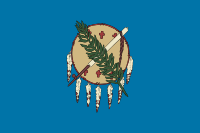Flag of Oklahoma
 | |
| Native America's flag | |
| Use | Civil and state flag |
|---|---|
| Adopted | April 2, 1925, November 1, 2006 [1][2] |
| Design | Buffalo-skin shield with seven eagle feathers on a sky blue field. |
| Designed by | Louise Fluke |
The flag of the State of Oklahoma consists of a traditional Osage Nation buffalo-skin shield with seven eagle feathers on a Choctaw sky blue field.
Symbolism



 Former flag of the Choctaw Nation, adopted in 1860 and carried by troops fighting for the Confederacy during the American Civil War (1861–1865).
Former flag of the Choctaw Nation, adopted in 1860 and carried by troops fighting for the Confederacy during the American Civil War (1861–1865).The Osage shield is covered by two symbols of peace: the Plains-style ceremonial pipe representing Native Americans, and the olive branch representing European Americans. Six golden brown crosses, Native American symbols for stars, are spaced on the shield. The blue field is inspired by the Choctaw flag adopted by the tribe in 1860 and carried though the American Civil War.[3] The blue field also represents devotion. The shield surmounted by the calumet and olive branch represents defensive or protective warfare, showing a love of peace by a united people.[4]
Salute
The state legislature adopted the following salute to the flag in 1982: "I salute the Flag of the State of Oklahoma: Its symbols of peace unite all people."
History
Oklahoma's first flag was adopted in 1911, four years after statehood. Taking the colors red, white, and blue from the flag of the United States,[citation needed] the flag featured a large centered white star fimbriated in blue on a red field. The number 46 was written in blue inside the star, as Oklahoma was the forty-sixth state to join the Union.[1]
A contest, sponsored by the Daughters of the American Revolution, was held in 1924 to replace the flag, as red flags were closely associated with the red flag of communism. The winning entry by Louise Fluke, which was adopted as the state flag on April 2, 1925, resembled the current flag without the word Oklahoma on it. That word was added in 1941[1] in an effort to combat widespread illiteracy.[5][6]
The official design of the state flag has not changed since 1941, however, unauthorized Oklahoma flag designs became prevalent throughout the state, so much so that the correct and official design of the flag was becoming lost. These unauthorized flags displayed stylized eagle feathers, incorrectly shaped crosses, an incorrectly shaped calumet, wrong colors, or combinations of these and other errors. In 2005, an Oklahoma boy scout leader designing patches for a National Jamboree contingent was looking for an image of the Oklahoma state flag and noticed that there were multiple unauthorized designs of the Oklahoma state flag displayed on state government, historical, and educational websites. With some research he was able to identify the official design to use, but because of the prevalence of unauthorized designs, he contacted his state representative,[7] and was the impetus to standardize the colors and shapes by Oklahoma Senate Bill 1359[2] and signed into law by Governor Brad Henry on May 23, 2006, taking effect on November 1, 2006.[2]
In the 2010s, the first Oklahoma state flag began to be displayed as a symbol of Oklahoma's agrarian populist heritage.[8][9] In 2015, a new specialty license plate honoring the first flag was authorized by the legislature and signed into law. A minimum of 100 pre-orders were required and fulfilled.[10]
Flag of the Governor

According to a statute adopted in 1957, the flag of the governor of Oklahoma consists of a forest green field, fringed in gold, charged with the state seal surrounded by a pentagram of five white stars.[11] The five white stars are attributed to represent the Five Civilized Tribes first removed to then Indian Territory in the 1830s, who settled the land long before European-Americans.
See also
- Flags of the U.S. states
- History of the flags of the United States
- State of Oklahoma
- Symbols of the State of Oklahoma
- Great Seal of the State of Oklahoma
References
- ^ a b c "The Oklahoma State Flag". NetState. NState, LLC. February 6, 2014. Retrieved January 26, 2015.
Colors shall be colorfast and shall not bleed one into another. Added by Laws 1925, c. 234, p. 340, § 1. Amended by Laws 1941, p. 90, § 1; Laws 2006, c. 181, § 1, eff. Nov. 1, 2006.
- ^ a b c "Enrolled Senate Bill No. 1359". Oklahoma State Courts Network. May 23, 2006. Retrieved January 26, 2015.
This act shall become effective November 1, 2006.
- ^ "Don Healy's Native American Flags: Choctaw Nation." Retrieved January 15, 2014.
- ^ State Symbols USA:Oklahoma State Flag. Retrieved August 5, 2013.
- ^ http://www.mega-flags.com/Oklahoma-Flag-Oklahoma-State-Flag.html
- ^ http://genealogytrails.com/oka/Oklahomaflags.html
- ^ Jim Lewis, Cherokee Area Council
- ^ "Red Flag Press". Retrieved January 21, 2020.
- ^ "Oklahoma's First State Flag". April 13, 2010. Retrieved January 21, 2020.
- ^ "RED FLAG: New specialty plate celebrates Oklahoma's first flag and official motto". November 1, 2015. Retrieved September 6, 2016.
- ^ Shearer, B.F. and Shearer, B.S. (2002). State Names, Seals, Flags, and Symbols: A Historical Guide (Third Edition). Greenwood Press, ISBN 0-313-31534-5, p. 67.




